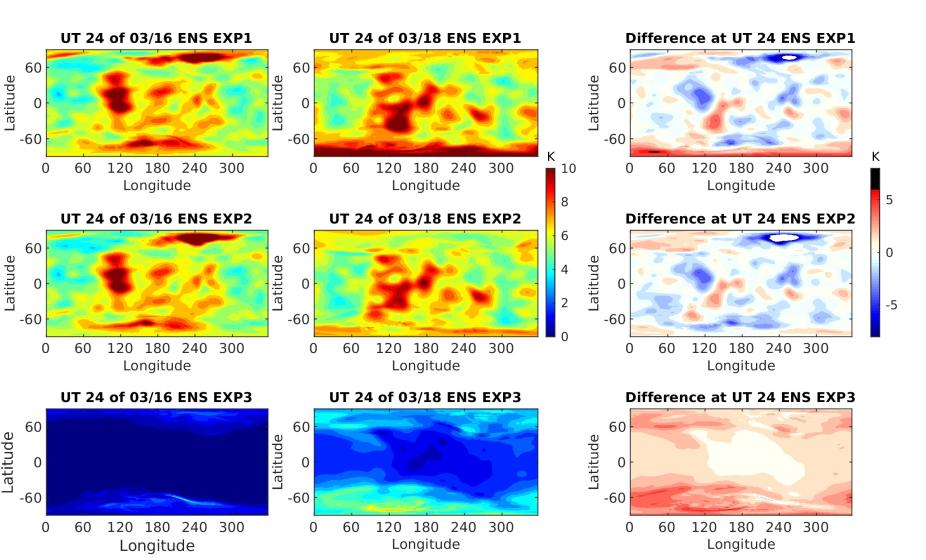
Longitude-latitude maps of the the STDs of neutral zonal wind computed from WACCM-X ensembles at 4.687*10^-8 hPa pressure level. From top to bottom are results from experiment with lower atmospheric forcing perturbation (ENS EXP2), with magnetospheric forcing perturbation (ENS EXP3), and with both lower atmospheric forcing perturbation and magnetospheric forcing perturbation (ENS EXP1). The first and second columns are the STD of the WACCM-X ensemble at at UT 1200 of 15 and 18 March, respectively. The third column is the difference between the STD at at UT 1200 of 15 and 18 March. The red scale in the third column's subplots means that the STD at UT1200 of March 18 is larger than that at UT1200 of 15 March; the blue scale means that the STD at UT1200 of 18 March is smaller than that at UT1200 of 15 March.
Upper-atmospheric weather prediction is subject to various types of forcing uncertainties. Understanding the sensitivity of the thermosphere and ionosphere to forcing uncertainties under different geomagnetic conditions is critical for space weather predictions. Ensemble simulations of a whole atmospheric model, the National Center for Atmospheric Research Whole Atmosphere Community Climate Model with thermosphere and ionosphere eXtension (WACCM-X), with various kinds of forcing perturbation is used to evaluate the upper atmosphere's response to the uncertainties of different forcings. Two kinds of forcing uncertainties are addressed: the lower atmospheric wave and tide forcing uncertainties and high-latitude electric potential uncertainty. These uncertainties are estimated in different ways and applied to generate forcing perturbations in the WACCM-X. WACCM-X can simulate the upper atmosphere's response to the uncertainties of the lower atmospheric wave and tide forcings related to different lower atmospheric conditions. High-latitude electric potential uncertainty is estimated based on the SuperMag and SuperDARN data through the Assimilative Mapping of Geospace Observations, which is applied to generate the forcing perturbation of high-latitude electric potential in the WACCM-X. The results show that the impact of high-latitude electric potential uncertainty is significant globally during the 2013 St. Patrick's Day storm. The lower atmospheric wave and tide forcing uncertainties result in a global impact on the upper atmosphere in the model. The sensitivity of the upper atmosphere to both uncertainties is approximately the combination of the two individually, though the combined effects are not a linear sum, indicating non-linearities in the ionosphere and thermosphere response to forcing uncertainties.